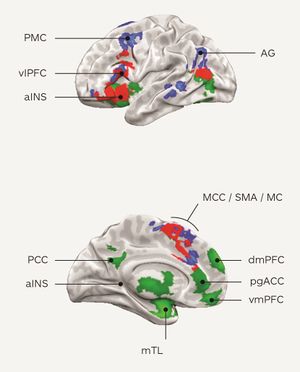Emotion regulation
Chapter 6 endnote 19, from How Emotions are Made: The Secret Life of the Brain by Lisa Feldman Barrett.
Some context is:
Some scientists refer to the control network as an “emotion regulation” network. They assume that emotion regulation is a cognitive process that exists separately from emotion itself, say, when you’re pissed off at your boss but refrain from punching him.

Many scientists assume that emotion regulation either precedes an emotion (e.g., it is possible to modify an emotion by choosing to avoid certain situations, or changing the interpretation of a situation) or follows an emotion (e.g., it is possible to modify an emotion by suppressing its expression).[1] A recent meta-analysis of 48 brain imaging studies found that when people engage in a particular type of emotion regulation called reappraisal—when they re-interpret the meaning of a situation or stimulus that evokes emotion—they in fact show a consistent increase in activity within the regions of the control network.[2] This increase was associated with a reduction in amygdala response, which scientists often (mistakenly) take as evidence of reduced emotional responding and therefore successful emotion regulation. In actuality, the control network is involved in the continual construction of and arbitration between instances of concepts that are necessary for making (and re-making) emotions. Consistent with this idea, we can see that brain regions with the control and interoceptive networks show consistent increases in activity during emotional experience (green), emotion regulation (blue), and their overlap (red) (see Figure, adapted from meta-analyses of studies of emotion[3] and reappraisal[2]).[4]
Concepts do, in fact, dictate interoceptive predictions, as well as action, but this process is of course not specific to emotion. “Reappraisal” is just a name that describes the changes from one instance of a concept to another.
The various names for different regulation strategies—suppression, distraction, reappraisal—just describe different ways that your brain's control network manages concept formation while processing prediction and prediction error in serve of categorization.
Notes on the Notes
- ↑ See Gross, James J. 2013. Handbook of Emotion Regulation. Guilford.
- ↑ 2.0 2.1 Buhle, Jason T., Jennifer A. Silvers, Tor D. Wager, Richard Lopez, Chukwudi Onyemekwu, Hedy Kober, Jochen Weber, and Kevin N. Ochsner. 2014. "Cognitive reappraisal of emotion: a meta-analysis of human neuroimaging studies." Cerebral Cortex 24 (11): 2981-2990.
- ↑ Satpute, Ajay B., Jian Kang, Kevin C. Bickart, Helena Yardley, Tor D. Wager, and Lisa F. Barrett. 2015. "Involvement of sensory regions in affective experience: a meta-analysis." Frontiers in Psychology 6: 1860. doi: 10.3389/fpsyg.2015.01860.
- ↑ Clark-Polner, Elizabeth, Wager, Tor D., Satpute, Ajay B., & Barrett, Lisa Feldman. 2016. "Neural Fingerprinting: Meta-Analysis, Variation, and the Search for Brain-Based Essences in the Science of Emotion." In Handbook of Emotions, 4th edition, edited by Lisa Feldman Barrett, Michael Lewis, and Jeannette M. Haviland-Jones, 146-165. New York: Guilford Press.